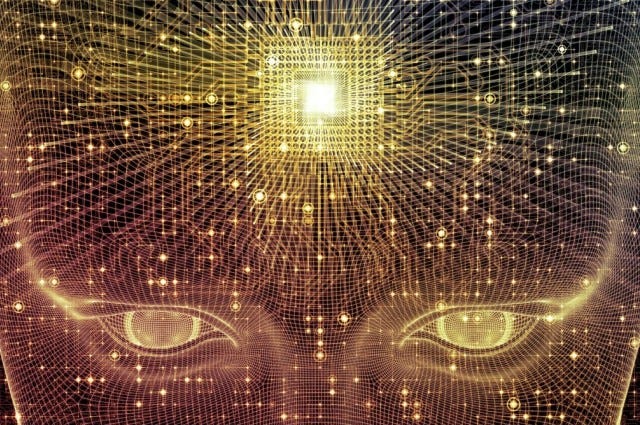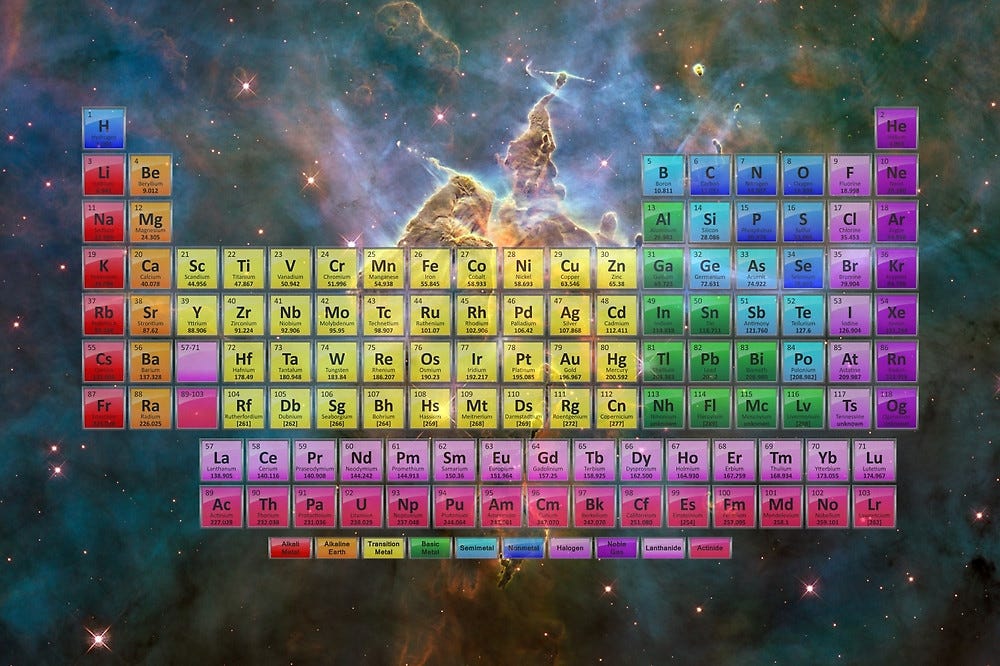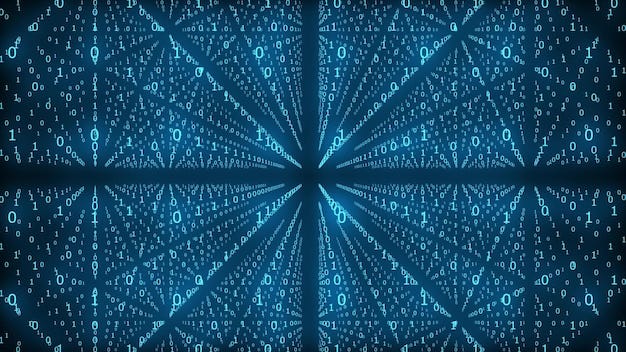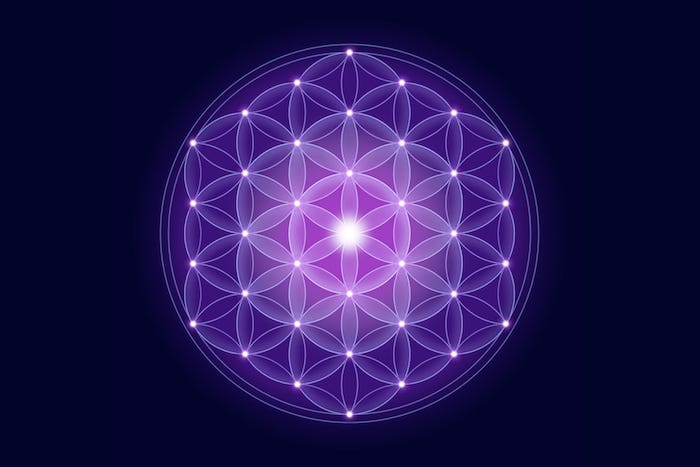With all of the huff and fluff surrounding psychedelics these days, combined with research into a someday/maybe Artificial General Intelligence that Knows All and Sees All, more people than ever are geeking out and wondering about the nature of mind and information.
These speculations don’t always end well.
As often as not, the types that are prone to direct-to-camera testimonials on Instagram hold forth with utter conviction precisely how they (and you can too! click on the link in the bio) can “download” galactic codes, align with the Universe, manifest your deepest desires, hack innovation to crush your competition, find your eternal Twin Flame, or a slew of other aspirational goals to level up your life.
All from tapping into the infinite wisdom and information of The Universe!
The only problem is 99% of them have no idea what they’re talking about.
Most of what pollutes the social media landscape is reheated New Thought/Law of Attraction (starting back at the end of the 19th century with Mary Baker Eddy, moving into mid-century with Norman Vincent Peale, and into the Secret and today’s #luckygirls on TikTok).
It’s just been slicked up with better graphics and shamelessly shilled by the latest carnival barkers of the Mysto.
#foolsrushin
#thoughtsbecomethings
Regardless of this questionable advice, more and more folks are accessing peak states and they are taking them seriously enough to build their entire lives around.
It seems timely and important to start mapping that information space a little more clearly.
After all, it could be the Universe talking to us in our dreams and visions. It could also be early onset schizophrenia, drug-addled mania, or even Satan (he’s got a reputation for being a bit tricksy in these departments).
If we’re considering entrusting our lives and our futures to these self-disclosing insights, we need to have a provisional understanding of where the information in non-ordinary states comes from.
We should at least ponder the yonder.
So let’s take four simple thought experiments one at a time to see what seems most plausible. From there, we can start to formulate a physics of the metaphysics.
Information Theory
We are a way for the universe to know itself. Some part of our being knows this is where we came from. . . . We’re made of star stuff.
—Carl Sagan
Without engaging in metaphysical guesswork, we can explore several explanations of the Information Layer that don’t require leaps of faith. They represent reasonable inferences from established science. That’s not to say any of these will turn out to be true. Advances in theory, measurement, and exploration will certainly replace them with more accurate models over time.
What follows are four explanations for where the information in peak states comes from, starting from the most empirical to the more conjectural . . .
Explanation One: The Umwelt Effect
At all times, the raw data of reality is blowing past us at millions of bits per second. Most of that time, our regular waking consciousness, tuned and calibrated to the “overworked primate”setting, ignores nearly all of it. That’s what Henri Bergson and Aldous Huxley called the “reducing valve of consciousness.” Our conscious mind, for example, processes information at about 120 bits per second. Our retina processes up to 11 million bits. In a non-ordinary state, we expand that reducing valve and our umwelt—or the portion of reality that we can perceive expands with it.
Hopped-up neurochemistry, hyperconnected neuroanatomy, and optimized neuroelectricity let us pick up on more of what’s swirling past us every second anyway.
It may seem supernatural, but really it’s just more data. For a strict materialist, this is the leanest, most Occam’s razor–ish explanation. “The universe is full of magic things,” Eden Phillpotts wrote, “patiently waiting for our senses to grow sharper!” Peak states sharpen our senses enough to perceive a little more of that magic.
Explanation Two: The Ancestor Effect
In the past decade, a slew of studies have traced markers of physical and mental health getting passed down from generation to generation. From remote arctic villages in Sweden to the descendants of Confederate POWs, survivors of the Holocaust, and long-suffering lab mice, we have suggestive evidence that there’s some form of legacy memory—both biological and psychological—that we inherit from our families.
The field of epigenetics is very much in its infancy, and researchers debate findings and methods with every newly published paper, but there’s a lot we are already learning from it. For example, methylation, i.e., the ability of genes to turn on or off depending on real-world conditions, RNA, a single-strand nucleic acid that signals to DNA, and histones, the proteins that DNA are scaffolded onto, are possible mechanisms by which we “remember” past generations’ experience. If, in non-ordinary states of consciousness, our umwelt expands, we might somehow access that accumulated experience more consciously.
That kind of ghostly intuition would seem magical and definitely beyond our own personal knowing—like using a Lifeline Call in the game show Who Wants to Be a Millionaire, but to our dearly departed instead of friends back home.
As far out as that sounds, it’s very much in keeping with indigenous and traditional cultures, from Native Americans to the Greeks and the Japanese. They each have “ancestor cults” where they seek guidance from those who have come before.
Extend that back through multiple generations, and there’s a distinct possibility that we hold within us, however dimly, some form of ancestral knowing that goes beyond culture and stories, and into the core of our biology. The latest science provides a plausible explanation for how that might be happening.
Explanation Three: The Starstuff
We share about 97 percent of the crucial building blocks of life—carbon, hydrogen, nitrogen, oxygen, phosphorus, and sulfur—with the rest of the galaxy. As Joni Mitchell sang, “We are stardust.” The raw materials of our bones, blood, and brains, the complex chemistry that fires our synapses and pumps our hearts, all come from the detritus of the Big Bang. We are that big, and that old.
In Living with the Stars: How the Human Body Is Connected to the Life Cycles of the Earth, the Planets, and the Stars, Stanford University professor Iris Schrijver concludes,
“Everything we are and everything in the universe and on Earth originated from stardust, and it continually floats through us even today. It directly connects us to the universe, rebuilding our bodies over and again over our lifetimes.”
It’s right there, in our DNA. Since Watson and Crick’s initial discovery, we’ve understood that our DNA contained the basic coding of all living things. More recently, we’ve begun to understand precisely how well those double helixes hold and store incredible amounts of information—up to five million times more efficient than current methods.
Yaniv Erlich, at Columbia’s Center for Computational Biology and Bioinformatics, says, “DNA has several big advantages . . . [it’s] been around for 3 billion years and humanity is unlikely to lose its ability to read these molecules.”
One group at the University of Texas recently encoded The Wizard of Oz in the universal language Esperanto onto a DNA strand. George Church at Harvard has managed to encode the 1902 silent film A Trip to the Moon onto a double helix. These examples concretely demonstrate the two-way street that connects data stored on DNA to our own lives and stories. We’ve moved from the realm of thought experiment to physical experiment.
If we follow these threads, they lead to a potentially startling implication. We are made of starstuff and share the chemical makeup of the galaxy. That much is known. DNA, responsible for the programming of all life, can be both encoded and decoded. It not only tells a cell to grow into a heart or a leg or a tree, it can hold a movie or the collected works of Shakespeare. And much, much more than that. It is one of the most efficient and resilient storage systems possible, across time and space.
In heightened states of consciousness, where our nervous systems are primed to perceive patterns and access information that isn’t normally accessible through waking awareness, is it possible that we can somehow “read” the information in our genetic DNA? And if we can, however clumsily or intuitively, decode that data, what story would it have to tell us?
In the beginning I Am. Before the moon and the stars, I Am. Before Abraham (or Instagram)
I AM.
Only in this thought experiment, the grand “I Am” is us. Encoded in our bodies, decoded by our brains, we find that we are literally the Alpha and Omega—we’ve been here all along. The raw materials of carbon, hydrogen, nitrogen, oxygen, phosphorus, and sulfur, the phosphates and sugars of the DNA strand make up all of life, and all of us. And the anamnesis—the forgetting of the forgetting that so often accompanies glimpses of Kairos—could be a remembering of that simple fact.
As Iris Schrivjer acknowledges, “Very little of our physical bodies lasts for more than a few years. Of course, that’s at odds with how we perceive ourselves. . . . But we’re not fixed at all. We’re more like a pattern or a process. . . . This transience of the body and the flow of energy and matter led us to explore our interconnectedness with the universe.”
In that stunning recognition, each of us can recognize ourselves as Omegans. But we’ll have to die to the illusion of our individual separation to glimpse it.
Explanation Four: The Information Layer
The first three explanations for where the information comes from have been, however hypothetical, still material. Umwelts and expanded data processing. Epigenetic signals passed down from parents. Our own DNA serving as a hard drive for the periodic table of the universe.
All still taking place within our physical bodies and brains.
This final explanation goes beyond that and considers the notion of a non-local source of all that inspiration.
For as long as philosophers have thought about it, they’ve supposed that there is a realm of reality beyond what our umwelt or five senses can perceive. That realm, they’d insist, is more true, more complete than anything we live in our day-to-day. Plato called it the Realm of Ideal Form. There, everything that we could ever experience exists first, in abstract, idealized perfection. An apple or a chair on this plane, according to Plato, is merely a partial representation of the original that lives in pristine suspended animation Out There.
Plato and later Western scholars also entertained the notion of the Aether—a kind of invisible background substance of the universe. The Aether was literally considered the substrate of all physical existence, serving as the carrier for everything from light to sound. But after centuries of consideration, Victorian physicists Michelson and Morley disproved this notion. Their refutation set the stage for Einstein’s theories of relativity and much of contemporary physics that came after.
But thinkers kept reaching for some metaphor to describe their glimpses of the Information Layer. Buckminster Fuller called it the Design Realm and credited his prodigious output in the fields of architecture, sustainability, and futurism to his access to that domain. He was merely transcribing what already was, he humbly maintained, not inventing new things from whole cloth.
In the twenty-first century, Hungarian physicist Ervin László called this hypothetical realm the A-field, or Akashic field, after the Sanskrit term for space. For him, the quantum vacuum stretches across time and space and carries information with it. If and when we access that field, we gain entry to a world of incredibly dense, non-local data. Think of accessing the A-field as closer to surfing the internet instead of picking the Encyclopaedia Britannica off the shelf.
For most of the modern era, pondering the Information Layer—whether the aether, or the noosphere, or something with “quantum” in the front of its name, was a dodgy career prospect. Scientists risked almost certain ridicule and marginalization for even considering that there was a there there, beyond thin air. After Michelson and Morley, those kinds of musings were decidedly non grata.
But they’ve never entirely disappeared, either. Lately, we may be coming full circle on the whole “where does the information come from?” inquiry.
The notion that the information doesn’t come from anywhere, but that it is present everywhere, is one of the more intriguing hypotheses in contemporary physics. While most scientists hold that the universe is made up of combinations of energy and matter, or even timespace, others hold that at its simplest expression, the universe is information.
Nineteenth-century mathematician Charles Babbage, polymath and inventor of the “Babbage Engine” proto-computer, was one of the first to assert that information was central and elemental. But it wasn’t until the 1980s when physicist John Wheeler, member of the Manhattan Project, collaborator on Einstein’s unified theory of physics, and coiner of the terms “black hole”and “wormhole,” brought that idea up to date.
In the spring of 1989 at the Santa Fe Institute, Wheeler presented a paper introducing his concept of “Its from Bits.” “It from Bit,” Wheeler wrote, “symbolizes the idea that every item of the physical world has at bottom—at a very deep bottom, in most instances—an immaterial source and explanation; that what we call reality arises in the last analysis from the posing of yes-no questions . . .; in short, that all things physical are information-theoretic in origin and this is a participatory universe.”
Wheeler’s participatory universe echoes Teilhard de Chardin’s Omega Point. In both frameworks, consciousness and existence culminate into a self-aware singularity. “Physics gives rise to observer-participancy,” Wheeler says, “observer-participancy gives rise to information; and information gives rise to physics.”
Round and round we go.
All of existence is encoded as information in the Either/Or of polar opposites, and according to Wheeler, we both observe that fact and participate in it.
From the Up or Down of electrons spinning across the universe, connected in their polarities no matter how far apart—to the ones and zeroes of computer coding, everything is a binary. Life or death. Fight or flight. Black and white. Friend or foe. Male or female. Heaven or hell. Alpha and Omega.
From the simplest building blocks of reality, to the survival mechanisms of single-celled organisms, to the vicissitudes of the human condition, we are hardwired for contrast.
To explain how we might access the nearly infinite amount information that makes up the universe, Oxford mathematician Roger Penrose has floated a theory that human brains, under certain specific conditions, are capable of quantum computing via microtubules in our neurons.
This idea would provide a structural explanation for seemingly impossible acts of cognition or intuition. While Penrose earned universal admiration (and a knighthood) for his work in mathematics, his theories of quantum consciousness have not been received as warmly.
Max Tegmark at MIT did the math and concluded that Penrose was off by at least ten orders of magnitude in his calculations of our mental capacities. “It’s reasonably unlikely,” Tegmark stated in a paper, “that the brain evolved quantum behavior.”
Stanford neuroscientist David Eagleman has cautiously resurrected an alternate explanation—what is known as the dualist argument of consciousness. The materialist argument insists that “mind” is only the by-product of activity in the brain. The dualist argument suggests that there is the hardware–the brain, and then there’s signal that the hardware picks up—the universe of information that Wheeler was talking about.
Eagleman writes in his book Incognito: “I’m not asserting that the brain is like a radio, but I am pointing out that it could be true. There is nothing in our current science that rules this out.”
Jeffery Kripal, professor of religion at Rice University and dedicated explorer of the weird and sublime, puts Eagleman’s theory in broader historical context.
“William James, Henri Bergson, and Aldous Huxley all argued the same long before Eagleman. Bergson even used the same radio analogy. This is where the historian of religions—this one, anyway—steps in. There are, after all, countless other clues in the history of religions that rule in the radio theory and that suggest, though hardly prove, that the human brain may function as a super-evolved neurological radio or television and, in rare but revealing moments when the channel suddenly “switches,” as an imperfect receiver of some transhuman signal that simply does not play by the rules as we know them.”
Einstein once said that “every true theorist is a kind of tamed metaphysicist.” It was true of his friend and colleague John Archibald Wheeler. It could be true for us as well. With the advent of repeatable practices that deliver us into the Information Layer, we get to explore the vastness of inspiration that is available.
“Can we ever expect to understand existence?” Wheeler wondered. “Surely someday, we can believe, we will grasp the central idea of it all as so simple, so beautiful, so compelling that we will all say to each other, ‘Oh, how could it have been otherwise! How could we all have been so blind so long!’”
Amazing Space, how sweet the Ground (of being).
We were blind, but now we see!












Jamie, I so often enjoy and appreciate your risking ability to interpret the maps and clues that woo the imagination to witness the imaginal, with the gumption and familial welcome to engage it. Your words are trellises. And as I climb, I often catch glimpses and fragrances where I can leap boldly, knowing if I fall I will land in the arms of tangled vines to begin again. And I love it. My own writing here, Regenerative Intimacy to Save The Earth, is pollinated by the heights your words have gifted to me. Thank you brother.
I think I’ve asked you before if you’ve read any of the Conversations With God books? It’s all in there.